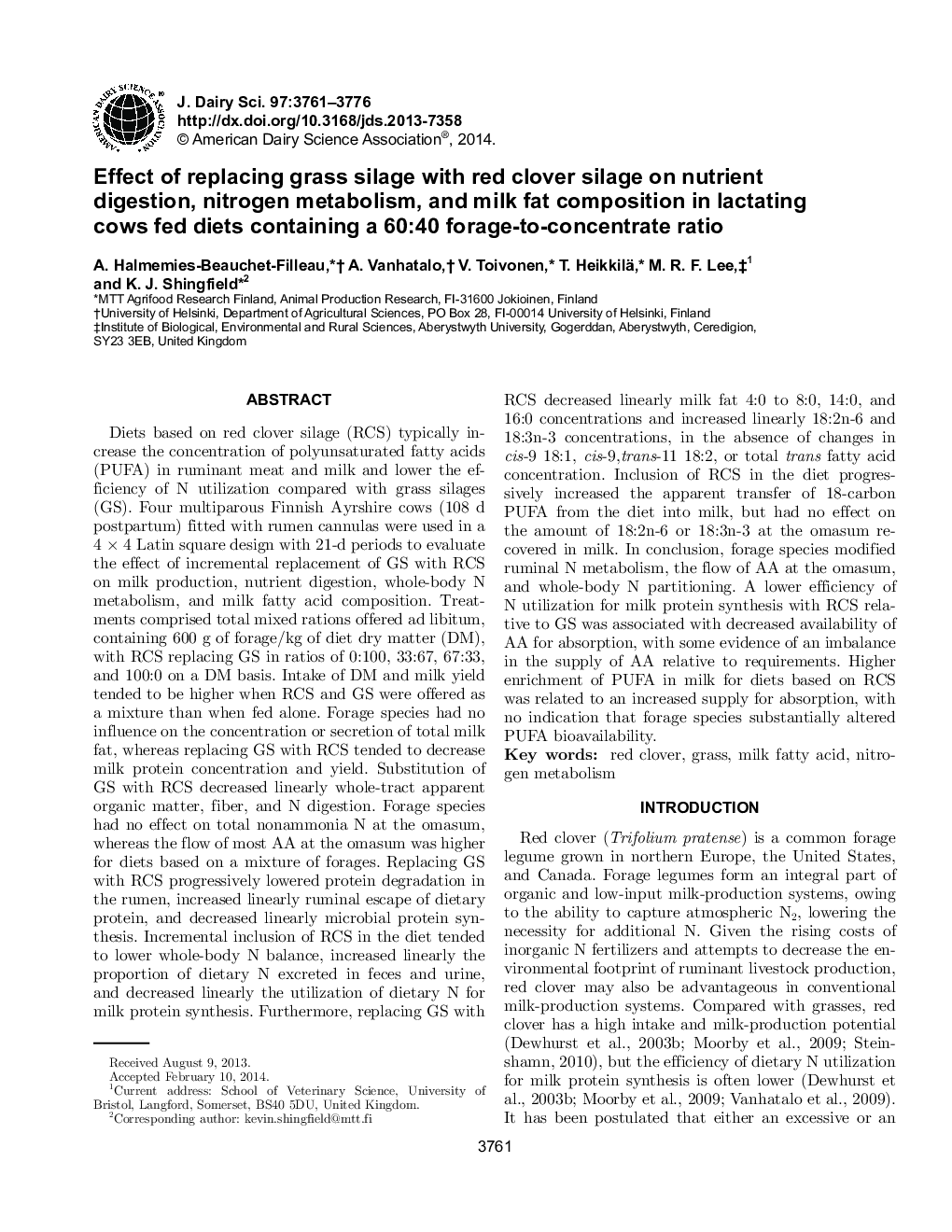| کد مقاله | کد نشریه | سال انتشار | مقاله انگلیسی | نسخه تمام متن |
|---|---|---|---|---|
| 10973934 | 1108020 | 2014 | 16 صفحه PDF | دانلود رایگان |
عنوان انگلیسی مقاله ISI
Effect of replacing grass silage with red clover silage on nutrient digestion, nitrogen metabolism, and milk fat composition in lactating cows fed diets containing a 60:40 forage-to-concentrate ratio
ترجمه فارسی عنوان
اثر جایگزین کردن سیلاژ علفی با سیلوهای سرخ مایل به قرمز بر هضم مواد مغذی، متابولیسم نیتروژن و ترکیب چربی شیر در گاو شیرده تغذیه شده با رژیم غذایی حاوی مقادیر علوفه ای به کنسانتره 60:40
دانلود مقاله + سفارش ترجمه
دانلود مقاله ISI انگلیسی
رایگان برای ایرانیان
کلمات کلیدی
شبدر قرمز، چمن، اسید چرب شیر متابولیسم نیتروژن،
موضوعات مرتبط
علوم زیستی و بیوفناوری
علوم کشاورزی و بیولوژیک
علوم دامی و جانورشناسی
چکیده انگلیسی
Diets based on red clover silage (RCS) typically increase the concentration of polyunsaturated fatty acids (PUFA) in ruminant meat and milk and lower the efficiency of N utilization compared with grass silages (GS). Four multiparous Finnish Ayrshire cows (108 d postpartum) fitted with rumen cannulas were used in a 4Â ÃÂ 4 Latin square design with 21-d periods to evaluate the effect of incremental replacement of GS with RCS on milk production, nutrient digestion, whole-body N metabolism, and milk fatty acid composition. Treatments comprised total mixed rations offered ad libitum, containing 600Â g of forage/kg of diet dry matter (DM), with RCS replacing GS in ratios of 0:100, 33:67, 67:33, and 100:0 on a DM basis. Intake of DM and milk yield tended to be higher when RCS and GS were offered as a mixture than when fed alone. Forage species had no influence on the concentration or secretion of total milk fat, whereas replacing GS with RCS tended to decrease milk protein concentration and yield. Substitution of GS with RCS decreased linearly whole-tract apparent organic matter, fiber, and N digestion. Forage species had no effect on total nonammonia N at the omasum, whereas the flow of most AA at the omasum was higher for diets based on a mixture of forages. Replacing GS with RCS progressively lowered protein degradation in the rumen, increased linearly ruminal escape of dietary protein, and decreased linearly microbial protein synthesis. Incremental inclusion of RCS in the diet tended to lower whole-body N balance, increased linearly the proportion of dietary N excreted in feces and urine, and decreased linearly the utilization of dietary N for milk protein synthesis. Furthermore, replacing GS with RCS decreased linearly milk fat 4:0 to 8:0, 14:0, and 16:0 concentrations and increased linearly 18:2n-6 and 18:3n-3 concentrations, in the absence of changes in cis-9 18:1, cis-9, trans-11 18:2, or total trans fatty acid concentration. Inclusion of RCS in the diet progressively increased the apparent transfer of 18-carbon PUFA from the diet into milk, but had no effect on the amount of 18:2n-6 or 18:3n-3 at the omasum recovered in milk. In conclusion, forage species modified ruminal N metabolism, the flow of AA at the omasum, and whole-body N partitioning. A lower efficiency of N utilization for milk protein synthesis with RCS relative to GS was associated with decreased availability of AA for absorption, with some evidence of an imbalance in the supply of AA relative to requirements. Higher enrichment of PUFA in milk for diets based on RCS was related to an increased supply for absorption, with no indication that forage species substantially altered PUFA bioavailability.
ناشر
Database: Elsevier - ScienceDirect (ساینس دایرکت)
Journal: Journal of Dairy Science - Volume 97, Issue 6, June 2014, Pages 3761-3776
Journal: Journal of Dairy Science - Volume 97, Issue 6, June 2014, Pages 3761-3776
نویسندگان
A. Halmemies-Beauchet-Filleau, A. Vanhatalo, V. Toivonen, T. Heikkilä, M.R.F. Lee, K.J. Shingfield,
